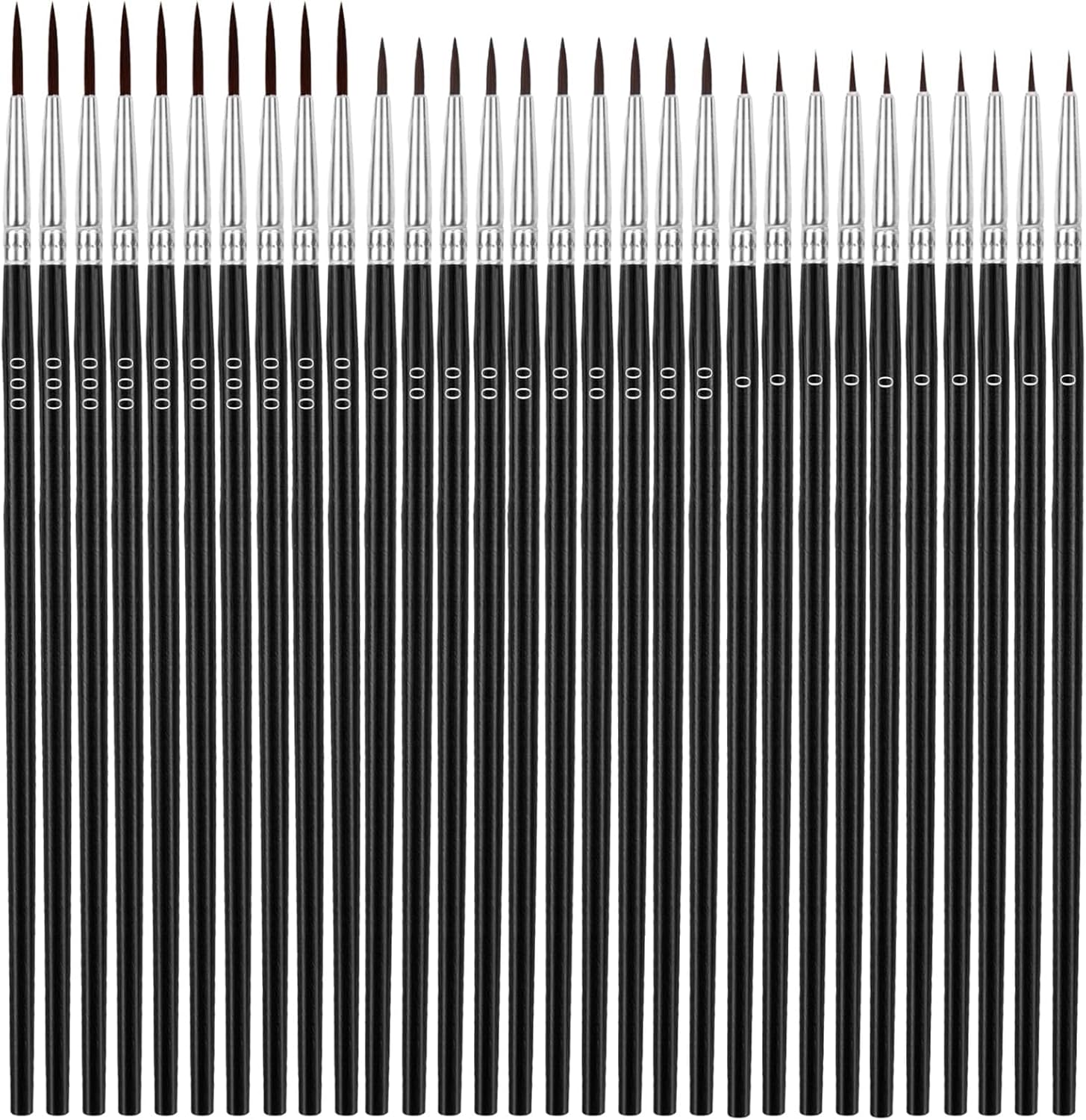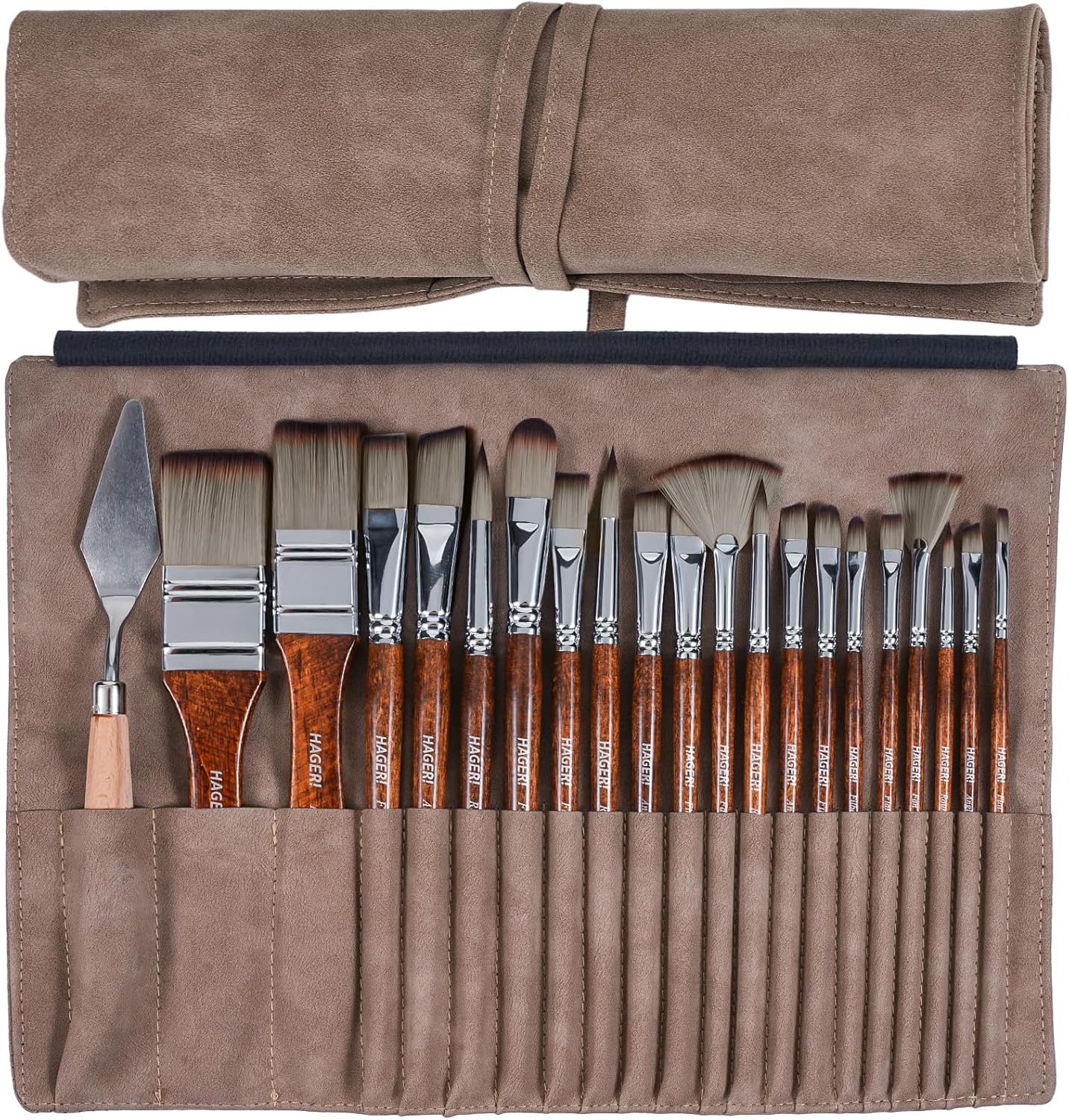Acrylic painting is one of the most popular and versatile mediums for artists, whether you’re a beginner or a seasoned pro. But here’s the catch: selecting the right paintbrush is essential to making your acrylic paintings shine.
You can have all the colors in the world, but without the right tools, you might find yourself struggling with your brushstrokes or, worse yet, achieving uneven results.
Have you ever gotten frustrated with your brush not doing what you want it to do? Whether it’s the brush leaving streaks, the bristles fraying, or simply not holding enough paint finding the right acrylic paintbrush can be a game-changer.
In this post, I’ll guide you through everything you need to know about choosing the best paintbrushes for acrylic painting.
From types and shapes to material and maintenance tips, we’ll explore all the details that can make a significant impact on your art.
| Product Image | Product Name | Features | Price |
|---|---|---|---|
 |
Professional Artist Paint Brush Set of 12 | Includes 12 brushes in assorted shapes and sizes Multi-Medium Compatibility Soft Yet Durable Bristles Easy-Grip Handles Works on Multiple Surfaces |
Check Price |
 |
CONDA Paint Brushes Set of 24 Different Shapes | Complete 24-Brush Assortment Roll-Up Nylon Storage Pouch Multi-Medium Compatibility Comfortable Grip Handles |
Check Price |
 |
18 Piece Paint Brush Set | Premium Nylon Bristles Water-Resistant Design 15 Brush Shapes & Sizes No Hair Loss Comfortable Grip |
Check Price |
 |
FENORKEY Artist Watercolor Paint Brushes | Anti-Shedding Construction Waterproof Wooden Handles Flexible Nylon Brush Tips 12 Assorted Sizes |
Check Price |
 |
Nicpro 10 PCS Flat Paint Brush Set | Includes 10 flat brushes High-Quality Synthetic Bristles Birch Wood Handles Double-Crimped Aluminum Ferrules |
Check Price |
 |
Transon Art Painting Brush Assorted Set of 12 | Assorted Brush Types Full-Length Brushes Soft & Absorbent Taklon Bristles Multi-Medium Compatibility |
Check Price |
 |
Bougimal 32 Pieces Paint Brush Set | Includes 32 brushes in assorted shapes Soft, elastic, and highly absorbent bristles Treated with non-toxic waterproof varnish Anti-Shedding Design |
Check Price |
 |
Grabie Paint Brush Set | Includes brushes from ultra-fine 5/0 to size 7 Universal Paint Compatibility Precision Synthetic Bristle Chrome-Plated Ferrules Easy to Clean & Maintain |
Check Price |
 |
ARTIFY 15-Piece Professional Oil Paint Brush Set | Includes six essential brush shapes Natural Wooden Handles White Copper Ferrules Comfortable Grip for Long Sessions |
Check Price |
 |
Acrylic Paint Brushes Set | 12 Assorted Sizes Comfortable Length Range All-Purpose Compatibility Durable Nickel Ferrules Lacquered Wooden Handles |
Check Price |
 |
Anezus Tiny Detail Paint Brushes | Assorted Hair Lengths Premium Synthetic Bristles Anti-Rust Nickel Ferrules Multi-Medium Compatibility |
Check Price |
 |
Winsor & Newton Winton Long Handle Brush | Corrosion-Resistant Ferrules Resilient Shape Memory Easy to Clean & Maintain Classic Wooden Handle |
Check Price |
 |
HAGERI 20 Pieces Paint Brushes | Includes 20 frequently used brush shapes Crafted from polyester and nylon Double-crimped and glued for extra strength |
Check Price |
Brush Types & Their Roles
Acrylic brushes come in many shapes and sizes, and each serves a different purpose. The most common types include:
- Flat Brushes: These have a square shape with flat edges. They’re perfect for bold strokes, creating sharp lines, and filling in large areas. If you’re working on detailed backgrounds or want to block in color quickly, flat brushes are your go-to tool.
- Round Brushes: Ideal for creating detailed lines and intricate designs. Their pointed tip allows you to create thin, precise strokes. A round brush is great for adding fine details to your artwork, such as delicate lines or highlights.
- Filbert Brushes: Combining the features of both flat and round brushes, filberts have a slightly rounded edge. This brush is ideal for blending and creating soft, curved strokes. It’s a great all-purpose option for artists who like versatility.
- Fan Brushes: Used primarily for texture, fan brushes are great for creating natural textures like grass or tree leaves. They have a flat, spread-out design that makes them excellent for adding layers of texture or creating soft effects.
Brush Sizes & Their Uses
Brushes come in a wide range of sizes, from tiny detail brushes to large brushes that cover vast areas. Understanding what each size is best used for can prevent frustration during the painting process.
- Small Brushes (sizes 0-4): Best for intricate details like fine lines, highlights, and small objects.
- Medium Brushes (sizes 6-8): Ideal for general painting, covering moderate surface areas, and applying moderate details.
- Large Brushes (sizes 10 and up): These are perfect for large canvases or quick applications of paint, especially if you’re working on backgrounds or large areas of color.
Brush Materials: Natural vs. Synthetic Bristles
Acrylic paintbrushes come with two main types of bristles—natural and synthetic. Each has its advantages, and choosing between them depends on your style and the effect you want to achieve.
- Natural Bristles: These brushes are made from animal hair, usually hog or sable, and are typically more absorbent. They work well for oil-based paints, but for acrylics, they can sometimes absorb too much paint or dry out too quickly. However, they are excellent for blending and fine detail work, though they’re generally more expensive.
- Synthetic Bristles: Synthetic brushes are made from nylon or polyester fibers and are a more budget-friendly option. They don’t absorb as much paint, which means they’re great for acrylics, as the paint stays on the surface longer and doesn’t dry out quickly. Synthetic brushes are more durable and easier to clean.
Choosing the Right Brush for Your Painting Style
When choosing a paintbrush, consider the type of acrylic artwork you plan to create. Are you focusing on detailed, realistic work, or are you more interested in abstract expressionism with bold strokes and textures?
For Detailed Work:
If you’re working on fine details, you’ll want a round brush or a small filbert. Round brushes, particularly those with a pointed tip, are excellent for creating tiny lines or highlights.
If you’re painting realistic portraits or still-life subjects, you’ll likely need a variety of small brushes for the detailed strokes.
For Textured Effects:
Fan brushes are great for adding texture, while flat brushes help create broad strokes. If you’re working on a large canvas with lots of layers and textures, a flat brush will cover more area in a shorter amount of time. It’s a must-have for bold strokes, quick applications, and working on larger works.
For Blending & Soft Transitions:
Filbert brushes are perfect for blending and creating smooth transitions between colors. Whether you’re blending a sunset sky or creating soft gradients in a portrait, a filbert brush can handle the job.
Acrylic Paintbrush Maintenance: Tips and Tricks
Taking care of your brushes will extend their lifespan and keep them performing well for years to come. Here are some tips for maintaining your acrylic paintbrushes:
1. Clean Brushes Immediately After Use
One of the biggest mistakes people make is letting acrylic paint dry on their brushes. Acrylic paint dries quickly, and once it’s dry, it’s much harder to remove from bristles.
Rinse your brushes immediately after use in warm water. Use soap or brush cleaner to remove any remaining paint.
2. Reshape Your Brushes
After cleaning your brushes, always reshape the bristles to maintain their form. You can do this by gently pressing them with your fingers and laying them flat to dry.
Avoid standing brushes upright in a cup, as water can seep into the ferrule (the metal part), leading to rusting or loosening bristles.
3. Store Brushes Properly
Storing your brushes properly is key to keeping them in good shape. Always store them in a place where the bristles won’t get bent out of shape. For example, keep them in a brush holder or flat in a drawer.
4. Don’t Leave Brushes in Water
While it may be tempting to leave your brushes soaking in water, don’t do it. The bristles can warp or split if they’re left in water for too long. Always clean your brushes right after use and dry them properly.
Common Mistakes to Avoid When Choosing Paintbrushes for Acrylics
Even experienced artists make mistakes when selecting their brushes. Here are some common errors to watch out for:
1. Not Considering Brush Size for the Job
Picking the wrong size brush for the job is one of the most common mistakes. If you’re working on a small canvas, using a large brush can make it difficult to achieve fine details. On the other hand, using a tiny brush for a large canvas can slow you down and make the work tedious. Always match your brush size to the scope of your painting.
2. Choosing Brushes Based Solely on Price
While price is an important factor, it shouldn’t be the sole deciding factor when choosing your brushes. A high-quality brush will perform better and last longer, ultimately saving you money in the long run.
Look for synthetic brushes designed specifically for acrylic paints if you’re on a budget. However, splurging on a few premium brushes for detail work might be worth it.
3. Not Cleaning Brushes Properly
As mentioned before, neglecting brush care can ruin even the most expensive brushes. Don’t fall into the trap of using dirty brushes or leaving acrylic paint to dry on your bristles. Keep your brushes in top condition with regular cleaning and proper storage.
A Quick Comparison: Types of Brushes for Acrylics
Here’s a helpful table summarizing the different types of acrylic brushes and their best uses:
| Brush Type | Best For | Recommended For |
| Round Brush | Fine details, thin lines, and precision | Portraits, fine details, adding highlights |
| Flat Brush | Bold strokes, filling large areas, sharp lines | Large areas, backgrounds, blocking in shapes, sharp edges |
| Filbert Brush | Soft blending and rounded strokes | Portraits, blending, smooth transitions |
| Fan Brush | Texture and creating natural effects | Textures like grass, leaves, or clouds |
| Angular Brush | Precise strokes and sharp angles | Edges, corners, and areas requiring sharp lines |
Conclusion: Choosing the Best Brush for Your Art
Selecting the right acrylic paintbrush can make all the difference in your artistic process. By understanding the different brush types, sizes, and materials, you can tailor your tools to fit your style and painting needs.
Remember, the best paintbrush is the one that feels most comfortable in your hand and suits the kind of art you want to create.
Before you purchase, think about the kind of work you’ll be doing, your preferred techniques, and your budget.
With the right paintbrush, your acrylic artwork will be that much better, and your painting process much more enjoyable.
I’d love to hear about your favorite brushes and painting experiences drop a comment below, or share this guide with fellow artists. Happy painting!
FAQs
1. Can I use regular brushes for acrylic painting?
While regular brushes can work in a pinch, it’s best to use brushes specifically designed for acrylics. Acrylic brushes are more durable and designed to handle the fast-drying nature of acrylic paint.
2. How do I prevent my brushes from fraying?
Proper cleaning and storage are key. Always wash your brushes immediately after use and reshape them to maintain their integrity. Avoid leaving brushes in water for extended periods.
3. What’s the difference between synthetic and natural bristles for acrylics?
Synthetic brushes are more durable and better suited for acrylics since they don’t absorb as much paint, preventing the bristles from drying out quickly. Natural bristles are more absorbent and ideal for oil-based paints.
4. How many brushes do I really need for acrylic painting?
Start with a few basic types: a round brush for detail work, a flat brush for larger areas, and a filbert for blending. As you develop your style, you can add more specialized brushes.
5. Is it worth investing in expensive paintbrushes?
If you’re serious about acrylic painting, investing in a good set of brushes can make a difference. However, you can still find excellent synthetic brushes at affordable prices that work well for acrylics. It’s all about finding the right balance for your needs.


